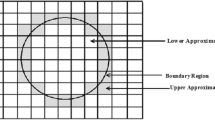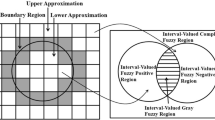Abstract
The interpretability of classifiers focused on numerical data continues to pose significant challenges. This paper introduces an interpretable classifier rooted in axiomatic fuzzy set (AFS) theory and granular computing (GrC). The design of the proposed classifier consists of three stages: the construction of hypersphere information granules, the optimization of hypersphere information granules, and finding the semantic description of hypersphere information granules by applying AFS theory. The resulting classifier leverages hypersphere information granules to capture the data’s structural characteristics while facilitating the semantic interpretation of the overall structural landscape. Comprehensive evaluation across 17 diverse datasets demonstrates that the proposed classifier achieves better classification accuracy and interpretability.












Similar content being viewed by others
Data availability
No datasets were generated or analyzed during the current study.
References
Alfeo AL, Cimino MG, Gagliardi G (2023) Concept-wise granular computing for explainable artificial intelligence. Granul Comput 8(4):827–838
Almeida LB (2020) Multilayer perceptrons. In: Handbook of neural computation. CRC Press, pp C1–C2
Bastos JA, Caiado J (2021) On the classification of financial data with domain agnostic features. Int J Approx Reason 138:1–11
Bernardo J, Berger J, Dawid A et al (1998) Regression and classification using Gaussian process priors. Bayesian Stat 6:475
Bezdek JC, Ehrlich R, Full W (1984) Fcm: the fuzzy c-means clustering algorithm. Comput Geosci 10(2–3):191–203
Breiman L (2001) Random forests. Mach Learn 45:5–32
Chen SM, Lee LW (2010) Fuzzy decision-making based on likelihood-based comparison relations. IEEE Trans Fuzzy Syst 18(3):613–628
Chen SM, Niou SJ (2011) Fuzzy multiple attributes group decision-making based on fuzzy preference relations. Expert Syst Appl 38(4):3865–3872
Chen SM, Wang JY (1995) Document retrieval using knowledge-based fuzzy information retrieval techniques. IEEE Trans Syst Man Cybern 25(5):793–803
Chen SM, Wang NY (2010) Fuzzy forecasting based on fuzzy-trend logical relationship groups. IEEE Trans Syst Man Cybern Part B (Cybern) 40(5):1343–1358
Chen SM, Ko YK, Chang YC et al (2009) Weighted fuzzy interpolative reasoning based on weighted increment transformation and weighted ratio transformation techniques. IEEE Trans Fuzzy Syst 17(6):1412–1427
Chen D, Xu W, Li J (2019) Granular computing in machine learning. Granul Comput 4:299–300
Cover T, Hart P (1967) Nearest neighbor pattern classification. IEEE Trans Inf Theory 13(1):21–27
De Ville B (2013) Decision trees. Wiley Interdiscip Rev Comput Stat 5(6):448–455
Deng Y, Liu X, **n C et al (2019) An interpretable classifier with linear discriminant analysis based on AFS theory. In: 2019 Chinese Control Conference (CCC). IEEE, pp 7583–7588
Dogan A, Birant D (2021) Machine learning and data mining in manufacturing. Expert Syst Appl 166:114060
Feng X, Liu X, Yaqing L (2014) Fuzzy classification algorithm based on fuzzy concept similarity and fuzzy entropy measure. J Dalian Univ Technol 54(2):240–245
Fix E, Hodges JL (1989) Discriminatory analysis: nonparametric discrimination: consistency properties. Int Stat Rev Revue/Internationale de Statistique 57(3):238–247
Fu C, Lu W, Pedrycz W et al (2019) Fuzzy granular classification based on the principle of justifiable granularity. Knowl-Based Syst 170:89–101
Fu C, Lu W, Pedrycz W et al (2020) Rule-based granular classification: a hypersphere information granule-based method. Knowl-Based Syst 194:105500
Ho TK (1995) Random decision forests. In: Proceedings of 3rd international conference on document analysis and recognition. IEEE, pp 278–282
Jia W, Liu X, Wang Y et al (2022) Semisupervised learning via axiomatic fuzzy set theory and SVM. IEEE Trans Cybern 52(6):4661–4674
Kamiński B, Jakubczyk M, Szufel P (2018) A framework for sensitivity analysis of decision trees. CEJOR 26:135–159
Kotsiantis SB (2013) Decision trees: a recent overview. Artif Intell Rev 39:261–283
Li Z, Wang C, Liu X et al (2021) Facial expression description and recognition based on fuzzy semantic concepts. Future Gener Comput Syst 114:619–628
Liu X, Liu W (2008) The framework of axiomatics fuzzy sets based fuzzy classifiers. J Ind Manag Optim 4(3):581–609
Liu X, Pedrycz W (2009) Axiomatic fuzzy set theory and its applications, vol 244. Springer
Liu X, Chai T, Wang W et al (2007) Approaches to the representations and logic operations of fuzzy concepts in the framework of axiomatic fuzzy set theory I. Inf Sci 177(4):1007–1026
Liu X, Feng X, Pedrycz W (2013) Extraction of fuzzy rules from fuzzy decision trees: an axiomatic fuzzy sets (AFS) approach. Data Knowl Eng 84:1–25
Liu X, Jia W, Liu W et al (2019) Afsse: an interpretable classifier with axiomatic fuzzy set and semantic entropy. IEEE Trans Fuzzy Syst PP(99):1
Loh WY (2011) Classification and regression trees. Wiley Interdiscip Rev Data Min Knowl Discov 1(1):14–23
Majumdar S, Laha AK (2020) Clustering and classification of time series using topological data analysis with applications to finance. Expert Syst Appl 162:113868
Mucherino A, Papajorgji PJ, Pardalos PM et al (2009) K-nearest neighbor classification. In: Data mining in agriculture, pp 83–106
Murtagh F (1991) Multilayer perceptrons for classification and regression. Neurocomputing 2(5–6):183–197
Pedrycz W (2018) Granular computing: analysis and design of intelligent systems. CRC Press
Pedrycz W, Al-Hmouz R, Balamash AS et al (2015a) Hierarchical granular clustering: an emergence of information granules of higher type and higher order. IEEE Trans Fuzzy Syst 23(6):2270–2283
Pedrycz W, Succi G, Sillitti A et al (2015b) Data description: a general framework of information granules. Knowl-Based Syst 80:98–108
Popescu MC, Balas VE, Perescu-Popescu L et al (2009) Multilayer perceptron and neural networks. WSEAS Trans Circuits Syst 8(7):579–588
Qian W, Xu F, Qian J et al (2023) Multi-label feature selection based on rough granular-ball and label distribution. Inf Sci 650:119698
Qin J, Ma X, Liang Y (2023a) Building a consensus for the best-worst method in group decision-making with an optimal allocation of information granularity. Inf Sci 619:630–653
Qin J, Martínez L, Pedrycz W et al (2023b) An overview of granular computing in decision-making: extensions, applications, and challenges. Inf Fusion 2023:101833
Rigatti SJ (2017) Random forest. J Insur Med 47(1):31–39
Scholkopf B, Sung KK, Burges CJ et al (1997) Comparing support vector machines with gaussian kernels to radial basis function classifiers. IEEE Trans Signal Process 45(11):2758–2765
Schulz E, Speekenbrink M, Krause A (2018) A tutorial on gaussian process regression: modelling, exploring, and exploiting functions. J Math Psychol 85:1–16
Shen Y, Pedrycz W, Wang X (2018) Clustering homogeneous granular data: formation and evaluation. IEEE Trans Cybern 49(4):1391–1402
Suthaharan S, Suthaharan S (2016) Support vector machine. In: Machine learning models and algorithms for big data classification: thinking with examples for effective learning. Springer, New York, pp 207–235
Vert JP, Tsuda K, Schölkopf B (2004) A primer on kernel methods. Kernel Methods Comput Biol 47:35–70
Wang AX, Chukova SS, Nguyen BP (2023a) Ensemble k-nearest neighbors based on centroid displacement. Inf Sci 629:313–323
Wang X, Yang J, Lu W (2023b) Bearing fault diagnosis algorithm based on granular computing. Granul Comput 8(2):333–344
**aodong L (1998) Fuzzy sets and systems based on AFS/structure, EI algebra and EII algebra. Fuzzy Sets Syst 95(2):179–188
**ng W, Bei Y (2019) Medical health big data classification based on KNN classification algorithm. IEEE Access 8:28808–28819
Xu L, Zhou X, Ren Y et al (2019) A traffic classification method based on packet transport layer payload by ensemble learning. In: 2019 IEEE Symposium on Computers and Communications (ISCC). IEEE, pp 1–6
Yan R, Liu X, Cao J (2011) A parsimony fuzzy rule-based classifier using axiomatic fuzzy set theory and support vector machines. Inf Sci 181(23):5180–5193
Yao JT, Vasilakos AV, Pedrycz W (2013) Granular computing: perspectives and challenges. IEEE Trans Cybern 43(6):1977–1989
Yin R, Lu W, Yang J (2024) A hypersphere information granule-based fuzzy classifier embedded with fuzzy cognitive maps for classification of imbalanced data. IEEE Trans Emerg Top Comput Intell 8:175–190
Ying C, Qi-Guang M, Jia-Chen L et al (2013) Advance and prospects of adaboost algorithm. Acta Autom Sin 39(6):745–758
Zadeh LA (1965) Fuzzy sets. Inf Control 8(3):338–353
Zhong H, Wang Y, Tu C et al (2020) Iteratively questioning and answering for interpretable legal judgment prediction. In: Proceedings of the AAAI Conference on Artificial Intelligence, pp 1250–1257
Acknowledgements
This work was supported in part by the National Natural Science Foundation of China under Grants 62073056 and 61876029; in part by the Applied Basic Research Program Project of Liaoning Province under Grant 2023JH2/101300207 and in part by the Key Field Innovation Team Project of Dalian under Grant 2021RT14.
Author information
Authors and Affiliations
Contributions
Han-Shen Wang completed the experiments and wrote the main manuscript. Wei Lu provided some main ideas and methodology. All authors reviewed the manuscript.
Corresponding author
Ethics declarations
Conflict of interest
The authors declare they have no conflict of interest.
Additional information
Publisher's Note
Springer Nature remains neutral with regard to jurisdictional claims in published maps and institutional affiliations.
Rights and permissions
Springer Nature or its licensor (e.g. a society or other partner) holds exclusive rights to this article under a publishing agreement with the author(s) or other rightsholder(s); author self-archiving of the accepted manuscript version of this article is solely governed by the terms of such publishing agreement and applicable law.
About this article
Cite this article
Wang, HS., Lu, W. An interpretable hypersphere information granule-based classifier for numeric data using axiomatic fuzzy set. Granul. Comput. 9, 66 (2024). https://doi.org/10.1007/s41066-024-00488-0
Received:
Accepted:
Published:
DOI: https://doi.org/10.1007/s41066-024-00488-0




